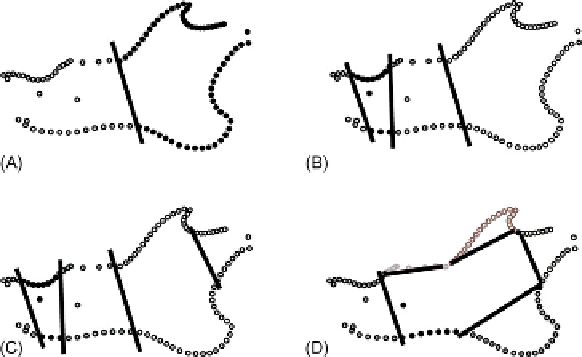Biology Reference
In-Depth Information
These two approaches to assessing the fit of a model to data can lead to conflicting
results because the model deviance increases when the predicted zero correlations are
actually high but not when the predicted high correlations are actually low. That is
because the predicted zero correlations are fixed to zero whereas the predicted high corre-
lations are estimated from the data. The consequence of erroneously predicting a high cor-
relation is to use up a degree of freedom unnecessarily. A matrix correlation, however, can
decrease when observed correlations are either lower or higher than predicted.
Examples: Evaluating Four Hypotheses of Mandibular Modularity
The first model that we will test is the Front/Back model (
Figure 12.17A
). The other
three are derived from developmental biology. We select these four from the large array of
hypotheses that could be derived from developmental biology and functional morphology
because all four can be tested by all the methods. Additionally, three of the models are
compatible with each other but the fourth is not compatible with any of the others. One
developmental model is based on a proposal by
Fish and colleagues (2011)
that the
Satb2-
positive cell population is a developmental (and macroevolutionary) module. Fish and col-
leagues propose that the mandible can be divided into four modules, identifying them
with skeletal units. One corresponds to the “Back” of the Front/Back model, the other
three are subdivisions of the front into three modules. One of these is the small distal
region that gives rise to the mandibular symphysis, the second is the incisor alveolar mod-
ule and the third the molar module, which includes the molar alveolus and the portion of
the ramus ventral to that (
Figure 12.17B
). The second model derived from developmental
biology (
Figure 12.17C
) contains the three Front modules of the
Satb2
hypothesis, adding
one to the back, corresponding to the expression domain of
goosecoid
, which has also been
proposed to be a developmental module (
Gaunt et al., 1993
). The fourth hypothesis
(
Figure 12.17D
) is the one proposed by
Atchley and Hall (1991)
, who regarded mesenchy-
mal condensations as the basic units of mandibular morphogenesis and condensations
have been explicitly identified as modules (
Hall and Miyake, 2000; Hall, 2003
). This one
FIGURE 12.17
Four hypothe-
ses of mandibular modularity. (A)
Front/Back model;
(B)
Satb2
model; (C)
Satb2
Gsc model; (D)
Condensation model. The black
lines
1
show the
subdivisions
between the modules.



